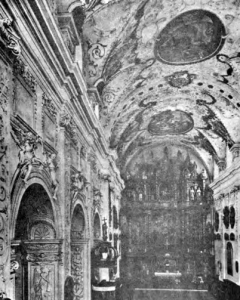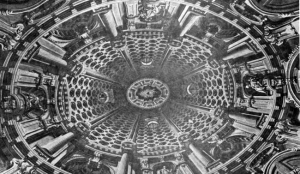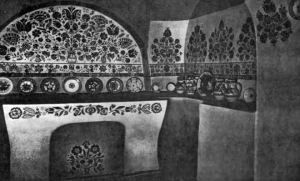Part I: Old World Origins
Political Developments to 1960
Political Activity, 18th and 19th Centuries
The intellectual movements of the 18th century were paralleled by political action as well. Once the embers of nationalism were stirred, the flame and the fire of patriotism began to spread to all levels of Slovak life and signaled the day when a breach with Hungary would become inevitable. The political effort was not circumscribed to men of action in the public forum nor did men of letters limit themselves to desk-bound tasks.
Political activity had many faces. Sometimes it was a violent and radical expression with force of arms. In times of revolutionary uprisings, as in 1848, there was bloodshed and many a supreme sacrifice for the nation and its rights. In a peaceful climate political action expressed itself in reasonable and justified petitions presented to the Emperor, memoranda of the Slovak people expressing their grievances, and there were appeals against oppression and denationalization, as well as pleas on behalf of self-determination and the right to live. Resistance to assimilation by the Magyars expressed itself first of all by demands for the recognition of Slovakia’s basic rights; e.g., to participate in legislative deliberations of the Diet, to use the Slovak language in courts of law and as the language of instruction in the schools, to be granted fair representation in the Diet.
Reprisals
In rallies and open-air meetings the populace manifested its support of the national movement; but the Magyar government responded only by reprisals, by further measures of denationalization, intimidation, imprisonment, gross fines, the closing of Slovak schools, confiscation of Slovak cultural institutes and libraries, the forced changing of geographic designations on the map as well as in local communities and sometimes even the compulsory Magyarizing of personal names, including patronymics. It was an out-and-out effort to destroy national identity as well as personal identity. In the words of the Magyar writer Bela Grunwald, the key purpose of the Magyars was “complete extermination of the Slovaks.”
The most appalling action was the government’s transfer of Slovak children, usually orphans, to the Hungarian lowlands. Thomas Capek in The Slovaks of Hungary (pp. 203-204) summarizes the matter in these words:
In its insane desire to denationalize Slovakia at all hazards, the Hungarian Government lent its aid to the “transportation” of Slovak children to pure Magyar districts.
The first expedition of this kind, conducted ostensibly under the auspices of the “Culture Society of Upper Hungary,” was undertaken in 1874, and netted 400 children. On the second expedition, in 1887, 190 youngsters were captured and separated from their parents without the latter’s consent. A third child-hunt took place in 1888, and with the assistance of gendarmes, 86 children were taken away. The fourth expedition organized in Liptov County brought only 15 children. The fifth child crusade is recorded in Nitra County in 1892, with 174 children being herded together for transportation to Magyar districts in the Hungarian lowlands. At about this time violent protest was raised against the inhuman practice and it was stopped.
Public Outrage
Early in the 20th century the plight of Slovakia came to be reported by writers and influential observers in the public forum outside of Hungary. R.W. Seton-Watson, who wrote under the pseudonym Scotus Viator (The Scottish Traveler), described the state of injustice that prevailed among the Slovaks and other minority groups in Hungary. Ernest Denis, the French scholar and writer, compiled the book Les Slovaques and showed great sympathy in dealing with the subject of the Slavs at the mercy of the government in Austria-Hungary.
The famed Norwegian writer Björnstjerne Björnson, winner of the Nobel prize in 1903, took up the cause of the Slovak people and in his writing exposed the inhumanities perpetrated against the Slovaks. Henry Wickham Steed, editor of the London Times, and William Ritter, the Swiss writer, also championed the oppressed Slovaks and expressed their admiration of the spirit with which these people endured unbelievable suffering and survived, and hoped to emerge victorious.
Hlasists
With the events of the notorious Bánffy election in 1896, political awareness and maturity reached a new phase for the Slovaks. They now determined to safeguard their rights through an effective political party of their own. Thomas G. Masaryk (1850-1937) began to influence many young Slovaks who were studying in Prague toward the close of the 19th century. Led by Dr. Vavro Šrobár and Dr. Pavel Blaho, they carried into the general thinking of the Slovaks considerable feeling for mutually friendly Slovak-Czech relationships. Their ideas were propagated chiefly through the publication Hlas (The Voice) and in time they came to be known as the Hlasists. Their movement could have ripened into a firmly unified force had they not assumed an anti-religious attitude which the Slovaks naturally found foreign to their deeply spiritual nature and sensibilities as well as to their traditional loyalty to the Church.
Father Hlinka
It fell to the lot of the Church to raise a worthy leader for the people. He was Father Andrew Hlinka (1864-1938) whose conscience laid it upon him to be priest and father to his people as well as their political defender. He bent all his energies to working primarily for and with the peasants. For their betterment he organized agricultural and credit unions and in the movement to liberate the peasant from the burdens that crushed him into servitude, he saw the pattern of liberation for the entire nation.
It was a matter of untold satisfaction for Father Hlinka to see at long last that Slovak deputies were making some gains in political elections. In 1901 there were two, and in 1905 there were four Slovaks elected to the Diet. In 1906, seven Slovaks won in the elections. In this election a total of 25 non-Magyar deputies came to office and their presence in the Diet became a matter of discomfort and apprehension to the Magyars who defensively resorted to sharp retaliation and worked to offset demands for equality for the Rumanians, Serbs, Croats and Slovaks. Their bitterest attacks were against Father Hlinka, who became the victim of imprisonment and clerical suspension from pastoral office.
During his imprisonment Father Hlinka devoted himself tirelessly to preparing a new Slovak translation of the Bible. He bore his church penalty in patience until Rome reviewed his case and he was finally vindicated and permitted to return to his parish in Ružomberok. Until his death he was involved in every significant event in Slovak history.
Milan R. Štefánik
In their desire to free themselves from the Magyar yoke, Slovak leaders started to explore possible federation with the Czechs and to examine prospects for Slovak autonomy. General Milan R. Štefánik (1880-1919) became a great force in the negotiations that developed with Masaryk and Beneš in planning the formation of a Czecho-Slovak state. Štefánik had academic training that prepared him for a brilliant career in astronomy and in mathematics and he achieved widespread recognition in both fields. When World War I broke out, he left the observatory in Morocco where he was engaged in a scientific project and joined the French army as a private. A little later he transferred to the French Air Corps.
A further war effort of Štefánik was the formation of a Slav foreign legion for which he recruited 6,000 men. American Slovaks and American Slavs responded to his call, and his visit to the United States in 1917 created great enthusiasm and support for the break with Hungary and the success of the allied forces. The very people who had been under tyranny and who chose exile in a free world in order to escape oppression in Austria-Hungary now became a vital power to break the bonds and to disarm the oppressor. Slovaks in America, far from their homeland, proved to be far more effective in dealing with the problem than if they were at home at the moment.
Independence, 20th Century
World War I finally brought about the dismemberment of Austria-Hungary and in the aftermath of the war, diplomats shaped the Czecho-Slovak republic. Unfortunately Štefánik was killed in a plane that crashed for questionable reasons on May 4, 1919 just before landing in Bratislava, and the new political state in the heart of Europe did not become the ideal partnership of Czech and Slovak brothers that it was meant to be. Both the Cleveland agreement of October 25, 1915 and the Pittsburgh agreement which Masaryk himself signed on May 30, 1918, carried clear provisions for autonomy and a federated union of states in which each partner was to enjoy equal rights. The Pittsburgh agreement distinctly spelled out the provision that “Slovakia shall have its own administration, its own parliament and its own courts.” The stern reality was that Prague was loath to honor the commitments that had been recorded in legal papers.


Since 1918, but particularly after 1920, there followed the thorny years of coming to an understanding with the Czechs. Unfortunately, from the outset, the government high-handedly treated the Slovaks as junior partners rather than co-equal partners in diplomacy and statesmanship.
American-Slovak Response
The Slovaks in America raised a great outcry against such injustice. In the homeland, Hlinka became the Slovak national champion who relentlessly pressed for self-rule for Slovakia. The struggle continued a long time. On June 5, 1938 a delegation from the Slovak League of America, headed by Dr. Peter P. Hletko who publicly displayed the original document of the Pittsburgh agreement, joined a massive demonstration of one hundred thousand Slovak patriots in Bratislava to manifest their endorsement of Hlinka and his Populist Party and to challenge the government to face the promises they made through their chief executive. This was Hlinka’s last public appearance.
World War II Period
Historically the period 1918-1939 was another testing time of the Slovak nation. Very often events in this era created intense tension and even presented a threat to national survival. Post-Munich Czechoslovakia became a dual state briefly. On March 14, 1939, after Hitler’s decision to make Czechia and Moravia protectorates of the Reich, the Slovak Parliament proclaimed the independence of Slovakia and established the Slovak autonomous republic under the presidency of Monsignor Joseph Tiso. Many skeptics had assumed that, left to its own assets and resources, Slovakia would never survive independently, yet in a highly critical period of world history, this young nation gained the recognition of 27 countries and it proved that an independent Slovakia is an economically viable country.
Communist Putsch
After World War II Slovakia was occupied by the Red army, the Czechoslovak Republic was restored on practically the same inequitable principles as it had had before, and with the same old problems — all this over and above the burden of the Communist system which was imposed upon it.
Alexander Dubček
Among most recent political developments was the liberalization program under Alexander Dubček and the revamping of political structures to effect autonomy for the Slovaks as well as for the Czechs under a new Czechoslovak constitution which provides for a federal state involving two distinct nations. Dubček initiated a program which departed from the heavy-handed policies of his predecessors. He did not enforce the repressive Soviet measures for he realized that Slovak people will never thrive under a system that negates the values of Western civilization. He proposed to “humanize” the Communist system, to relax the party’s grip on the national economy, to curb police power, to guarantee freedom of expression, to hear minority opinions in government, to rehabilitate political prisoners and to ease travel restrictions. These were some of his “January reforms” under which the country burgeoned into a new life. It is against such a way of life that the Soviets have sent their tanks, matching guns against ideas.
Though the Slovaks lost political independence with the fall of Great Moravia in the 10th century, their culture has not been destroyed. They have occupied their ancestral lands for long centuries without interruption and endured all the catastrophes that overtook them. Even under the Magyars they managed to become a cultural unit in central Europe with a university at Bratislava as early as the 15th century and later a Catholic university at Trnava in the 17th century. They have a distinctive literature, culture, history, economic capability, sociological and ethnographic individuality — the constituents of a nation.

